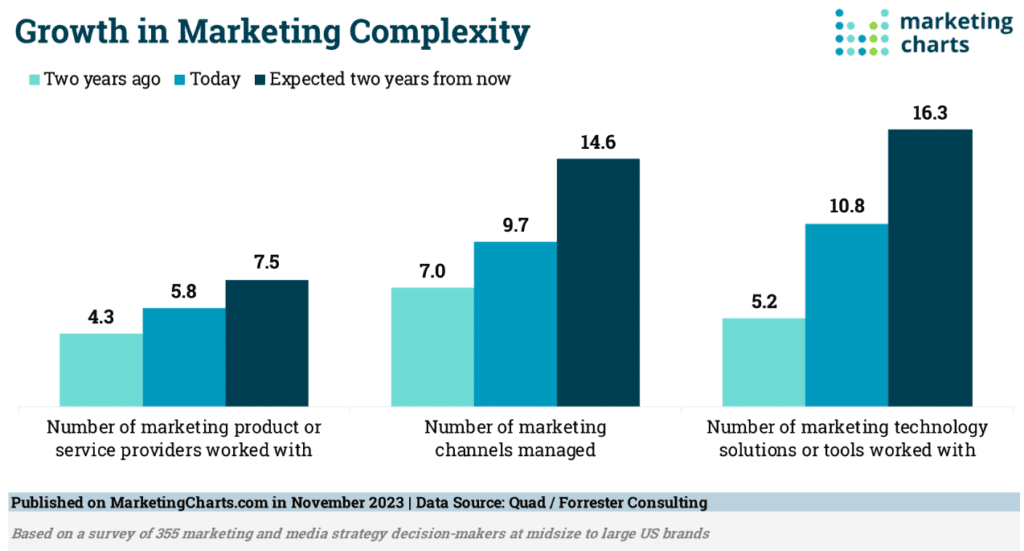How to Build a Marketing Team on a Budget





The communications ecosystem is growing more complex. In this post, we explore how you still build a marketing team without breaking the bank. ...
Let’s assume you, a marketing leader, have a well-built product, an interested audience, and the potential to capture at least some share of whatever sector it is that you do business in. You’ve built an internal marketing team or hired an agency partner to get the word out, but you can’t seem to get the critical mass you need to make it catch.
Organizations in this phase burn money quickly. As they move from one tactic to the next, stakeholders attempting to troubleshoot the challenge begin flailing. It’s a natural reaction to this type of business challenge, but the approach often does more damage than good. It also tends to be indicative of a problem solving approach that prioritizes easy answers over hard questions.
In reality, businesses and organizations fail for too many reasons to count. Many of the symptoms of this downward spiral first appear marketing-related, but their seeds are planted long before the first piece of copy is written. Solving these challenges requires a deeper systemic exploration of the full revenue ecosystem to turn the corner.
This guide was written to help you identify where to start looking.
Trying to attract all, or even multiple segments of a potential audience at once is like trying to accomplish multiple items on your to-do list simultaneously: Sometimes it works, but the more niches you add, the less effective it is. It can end up being a quick way to expend a lot of energy at once with very little result.
The symptoms of a marketing strategy that’s gone too wide often include messaging that fails to land, inability to drive critical mass, and brand awareness/recognition. Each of these alone can put a serious crimp in your marketing strategy. Together, they produce a lack of trust that will eventually lead to dilution of your marketing budget and failure.
Not only will focusing on a tighter audience make your messaging more effective, it will reduce the time and cost to acquire new buyers. It will also give you a group of customers through which you can grow social proof like testimonials, and case studies that will make expanding into new markets easier when the time comes.
For obvious reasons, the way that brick-and-mortar, hybrid, and online organizations choose what type of audiences to focus on differs, but the same overarching principles apply. Start from the most narrowly focused segment of your audience possible and use it as a stepping stone to continue building.
The purpose of marketing is to align your product/brand with a target audience. Your first instinct may be to create alignment based on age, gender, income, lifestyle, etc. We need to think more aspirationally, though. Don’t align your brand with your audience; align your brand with how your audience wants to be seen. What lifestyle, values, and interests do they want to convey about themselves?
When a brand is truly connects with its audience, it speaks to that audience’s desired perception of itself, whether they want to be seen as a loving caregiver or a Fortune 100 business executive. Every asset and piece of collateral your brand comprises helps shape and mature that vision, positioning your product as the object that will help them achieve it.
Remember that people don’t buy products; they buy brands. Making sure that your messaging is aspirationally-focused will reduce the amount of touches it takes to earn a new buyer and drive loyalty. The most iconic products in the world, from iPhone to salesforce to Target, all have one thing in common – aspirational messaging.


Your audience takes in ~60,000 gigabytes of media every day. What makes yours stand out? A bold product guarantee, a touching ad, an unhinged brand mascot? Your brand needs to cut through the malaise of everyday life and resonate. The goal of marketing, after all, isn’t simply to drive a sale but to stimulate the type of conversation that drives exponential growth.
At risk-averse brands, great marketing tends to crumble in the C-Suite when overly-cautious executives boil a message down to its most mundane components. It’s important for executives to know however that, at best, the inability to take communications risks will increase your marketing and advertising expenses ten-fold. At worst, it will drive you to bankruptcy.
While every brand’s risk tolerance will be different, our job as marketers is to create a memory associated with positive feelings that can be connected to our brand. If a brand fails to get out of its comfort zone, it will not grow. It needs to touch on some aspect of your audience’s personal experience in a way that shows you understand them. That requires taking a risk.
Simplicity is one of the most difficult skills to master for communications professionals and one of the most compelling for buyers. As marketers we have so much to say. From value propositions to pricing, it can be difficult to decide what matters the most. That sometimes leads to a glut of information that feels overwhelming and isn’t particularly compelling.
Remember that your audience is busy, has less bandwidth than you think, and just plain doesn’t care as much about what you’re selling as you do. We not only need to get to the point quickly, we need to do it in a compelling way.
“The most important rule of thumb in marketing is to not make people think more than they need to”.
Rion Haber
As described in the previous section, you need to paint a picture for your audience, and that requires some level of abstract thinking. Finding the balance between that abstraction and clear, simple, concise language can sometimes take years and is often defined as much by an audience’s feedback as often as some internal brainstorming session.
A good practice to start with when trying to simplify your message is to write out a long (five to seven sentence) description of your brand. Now begin reducing it to its most vital seven to ten words. Be ruthless – it doesn’t have to be grammatically correct.
When you do find the right combination, you’ll likely know it right away; it will feel direct, straight forward, and unassailable – a balance of voice, facts, tone, and tenor. Your audiences’ eyes will light up and they will want to learn more.
Peer-to-peer advocacy, or “word of mouth”, is the most effective form of marketing, and it’s not even close. Part of the reason is that generating great advocacy is difficult – much more so than placing a simple ad. That makes it rarer and more trustworthy. People trust the products that people go out of their way to recommend because it requires our most valuable asset – time.
While the path to advocacy isn’t simple, it is easy. Advocacy is the result of deep coordination between product, marketing, sales, and support – AKA “Revenue Operations”. When done well it can launch even average products and brands into the stratosphere without very little marketing spend. When disregarded, it can create an unsustainable cost of acquisition and loyalty.
To build advocacy, focus deeply on end-to-end brand experience. That is the product you build, how you talk about it, the promises you make, what is delivered, and how responsive you are to your customer’s experience throughout. You must look unflinchingly at the challenges your customers’ faces, even and perhaps most of all, the ones that they don’t communicate.
The “Rule of Seven” is an old marketing koan. It states, roughly, that the average audience member will have as many as seven brand engagements before taking action. It’s not a hard and fast rule, but it is a good starting point and the idea that we need to see messages multiple times before engaging has held remarkably consistent across mediums, channels, and time.
Whether you’re ideating on a future marketing strategy or taking a second look at your current one, you need to build multiple touches into your plan. The idea that your customers will see one message, one time, and make a purchasing decision isn’t out of the question if everything else is firing on all pistons, but it is highly unusual and comprise your strategy.
Start thinking about your marketing in terms of “brand experiences”. An experience can include any type of engagement with you – a message from a friend, a bad checkout experience, great customer experience. When we talk about touching customers seven times, stop think of touches as strictly ad-based and start thinking of them as experience-based.
If you’re feeling overwhelmed with the next steps, understand that you haven’t done anything wrong. Marketing today is complex. It requires a wide range of skill sets and expertise – from copywriting to technical development – to do well. Having one team member responsible for all of it rarely works and often leads to brand entropy, burnout, and frustration.
Small and fast-growing organizations face a particular challenge here: Bridging the gap between their own limited resources and the need to deliver on more complex strategies that support rapid growth. To build a campaign that hits all these points, you’re going to need an omnichannel team.
For most organizations, this is a bridge too far. They often try to find a single marketing unicorn and struggle to see any real growth. Working with multiple marketing agencies or contractors is another solution, but organizations often lose economy of scale and erode the ability between teams to deliver seamless omnichannel communications.
When transitioning from a small word-of-mouth driven micro business to a small or mid-sized organization, you’ll likely need to use a mix of internal or agency resources. Another popular option is an integrated marketing agency, like Catalyst, that will embed directly with your team, giving you the capabilities of a larger, advanced team without the overhead.
Remember that gaining new customers is ultimately about making a promise to your audience and following through with it at every stage of their journey. If you’re growing your brand, keep this checklist handy when building your marketing strategy. If you’re troubleshooting a current lack of business, it can be a useful tool to assess whether you’re delivering the kind of seamlessly integrated brand experiences that drive growth.



